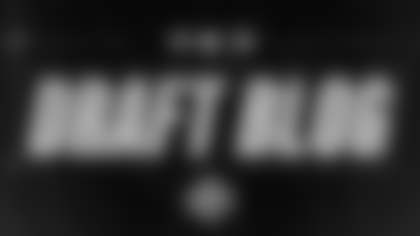Troy Polamalu. Santonio Holmes.
Each of those names holds its own special place in Steelers history, but it's at this point each year when they become inextricably linked. That's because it's now draft time on the NFL calendar, and for Steelers fans Polamalu and Holmes are the two most recent examples of their favorite team trading up in the first round to pick a targeted player.
In 2003, the Steelers traded up from 27th overall in the first round to 16th overall in the first round to select Polamalu, who helped the team win two Super Bowls and will attract serious consideration later this year to be elected to the Pro Football Hall of Fame in his first year of eligibility. In 2006, on the heels of winning Super Bowl XL, the Steelers traded up from 32nd overall in the first round to 25th overall to pick Holmes, whose catch in the back of the end zone in the final minute of Super Bowl XLIII was the difference in the team's victory over the Arizona Cardinals that capped the 2008 NFL season.
"We're always going to be open to either (trading up or trading down)," said General Manager Kevin Colbert, who took part in a joint news conference today with Coach Mike Tomlin a few days before the start of the 2019 NFL Draft. "Our scouts, the pro guys, will start making their calls starting today to visit with teams. We talk about it informally throughout the spring, but you never really get firm answers because we don't know what we would be trading up for and teams don't know what they'd be trading away from. Until you really get closer – you might have some idea that this team is interested in coming up and this team is interested in going down – until you actually get on the clock, those things will not happen in any great detail."
There's always interest among fans in having the Steelers trade up in the first round, and this year seems to be particularly so because of the need for the team to find a replacement for Ryan Shazier as an every-down linebacker and with the top two prospects (Devin White and Devin Bush) expected to be picked before the Steelers' turn comes in the first round.
With the Steelers having 10 total picks in this seven-round draft, and with a roster that as of this moment contains 51 players with NFL game experience, the outside perception as to what the team needs to return to the playoffs and make a run at a championship in 2019 is quality over quantity. Which would seem to make this a prime year in which the Steelers throw a package together to move up in the first round.
But even with that, there still is the issue of settling on compensation that both trading partners see as fair.
"Every year it's relative," said Colbert. "People talk about the (draft value) charts, but we don't use a chart. We know other teams will use a chart, and we know that when we call them (about a trade proposal) they'll say, well that doesn't match our chart value. That's fine. They can do that, but in our minds we have to spend what we want to spend if we want a certain player. And we have to explain, if a team is trying to trade up to us, that we don't follow a chart. We know what they're saying and that's up to them, but we make up our own values."
Colbert was involved in both of the trades that netted the Steelers Polamalu and then Holmes, and he reiterated that even now there is sometimes criticism for what was given in compensation in order to get into position to make those picks.
"I know we gave up a No. 3 and a No. 6 to go from 27 to 16 to pick Troy," said Colbert. "At pick 16 in that draft, we said (Polamalu) is worthy of getting picked at 16, so we were comfortable in making that trade. For Santonio (Holmes), we went from No. 32 to No. 25, and we gave up a third and a fourth. People said, you gave up too much. Well again, he caught the touchdown pass that won a Super Bowl, so did we really give up too much? No."
Colbert went on to explain that in deciding whether to try to trade up in a round, how far to trade up in a round, and then the compensation the Steelers would be willing to pay for the move has more to do with their own opinion of the player rather than what another team or teams might think of a player. As an example, it's not what the Dolphins or Bengals might think of a player that would motivate the Steelers to trade up, but what the Steelers think of the player that would be the impetus behind a trade.
"What we look at: If a certain player we think we would pick at No. 5 is still available at No. 10, we would say, this guy is coming to where he's available and we might want to think about going up to get him because he probably won't get to No. 12," said Colbert.
Added Tomlin, "Our desire to move is based on how the player is positioned on our board as opposed to how he might be positioned on another team's board."
And once the Steelers settle on a level of compensation they see as fair, Colbert isn't likely to throw in a sweetener at the last minute to close a deal. He explained his rationale this way:
"I always try to put a name to the pick," said Colbert. "People say, throw in a seventh-round pick. To that I say, you're throwing in Brett Keisel. We have to be careful about that. Or Kelvin Beachum. We try to maintain some sanity about saying, just give them whatever. When you put picks together, maybe you do what has worked for you in the past, but you also have to understand if you give up a seventh in this year's draft we might not be able to get that player we like down low. We just don't throw around numbers. We try to put names with the numbers."
And in the event a team might contact the Steelers about trading up into their spot to pick a player it was targeting, as Dallas did in 1990 when it moved up to draft Emmitt Smith or the New York Jets did in 2001 when it moved up to draft Santana Moss, Colbert said there is a specific protocol the team will follow in that event as well.
"We'll identify a group of players we wouldn't trade away from no matter what," said Colbert. "If they were available to us at 20 and some team came to us with draft picks, we've already determined we're taking that player (and not making a trade)."














